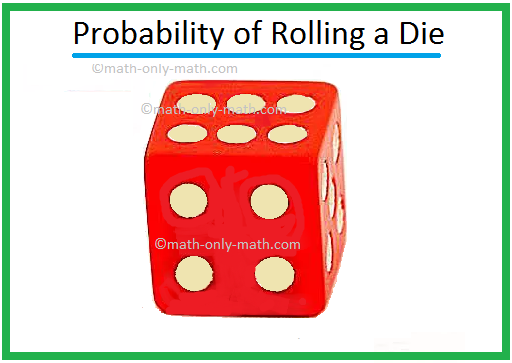Probability of Rolling a Die
We will solve different type of problems on probability of rolling a die.
1. A die is thrown 200 times and the numbers shown on it are recorded as given below:
If the die is thrown at random, what is the probability of getting a
(i) 4
(ii) 4 or 5
(iii) Prime number
Solution:
(i) Total number of trials = 200.
Number of times 4 appears = 28.
Therefore, the probability of getting 4 = Frequency of 4 AppearingSum of all the Frequencies
= Number of Times 4 AppearsTotal Number of Trials
= 28200
= 750.
(ii) Total number of trials = 200.
Number of times 4 or 5 appears = 28 + 26 = 54.
Therefore, the probability of getting 4 or 5 = Number of Times 4 or 5 AppearsTotal Number of Trials
= 54200
= 27100.
(iii) Total number of trials = 200.
Number of times a prime number appears = 48 + 36 + 26 = 110.
[Since 2, 3 and 5 are prime numbers and they appear 48, 36 and 26 times respectively).
Therefore, the probability of getting
a prime number = Number of Times a Prime Number AppearsTotal Number of Trials
= 110200
= 1120.
● Probability
- Probability
- Definition of Probability
- Random Experiments
- Experimental Probability
- Events in Probability
- Empirical Probability
- Coin Toss Probability
- Probability of Tossing Two Coins
- Probability of Tossing Three Coins
- Complimentary Events
- Mutually Exclusive Events
- Mutually Non-Exclusive Events
- Conditional Probability
- Theoretical Probability
- Odds and Probability
- Playing Cards Probability
- Probability and Playing Cards
- Probability of Rolling a Die
- Probability for Rolling Two Dice
- Probability for Rolling Three Dice
- Solved Probability Problems
8th Grade Math Practice
From Probability of Rolling a Die to HOME PAGE
Didn't find what you were looking for? Or want to know more information about Math Only Math. Use this Google Search to find what you need.
Recent Articles
-
Counting Numbers from 1 to 50 | Match the Number | Missing Numbers
Apr 04, 25 03:46 PM
In counting numbers from 1 to 50, recognize the numbers, count and then join the numbers in the correct number order. Here we mainly need eye-hand coordination to draw the picture and maintain the num -
Counting Eleven to Twenty with Numbers and Words |Numbers from 11 - 20
Apr 04, 25 03:21 PM
Counting eleven to twenty with numbers and words are explained below. One ten and one more is eleven. Eleven comes after ten. One ten and two more is twelve. Twelve comes after eleven. -
5th Grade BODMAS Rule Worksheet | PEMDAS | Order of operations|Answers
Apr 03, 25 03:11 PM
In 5th Grade BODMAS Rule Worksheet you will get different types of problems on mathematical expressions involving different operations, mathematical expression with 'brackets' and 'of' and simplifying… -
Worksheet on Simplification | Simplify Expressions | BODMAS Questions
Apr 03, 25 02:58 PM
In worksheet on simplification, the questions are based in order to simplify expressions involving more than one bracket by using the steps of removal of brackets. This exercise sheet -
Divisible by 2 Video |Test of Divisibility by 2 Trick| Rules| Examples
Apr 03, 25 10:25 AM
A number is divisible by 2 if the digit at unit place is either 0 or multiple of 2. So a number is divisible by 2 if digit at its units place is 0, 2, 4, 6 or 8.






New! Comments
Have your say about what you just read! Leave me a comment in the box below. Ask a Question or Answer a Question.